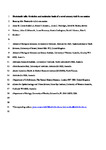Phototactic tails: Evolution and molecular basis of a novel sensory trait in sea snakes
| dc.contributor.author | Crowe‐Riddell, JM | |
| dc.contributor.author | Simões, BF | |
| dc.contributor.author | Partridge, JC | |
| dc.contributor.author | Hunt, DM | |
| dc.contributor.author | Delean, S | |
| dc.contributor.author | Schwerdt, JG | |
| dc.contributor.author | Breen, J | |
| dc.contributor.author | Ludington, A | |
| dc.contributor.author | Gower, DJ | |
| dc.contributor.author | Sanders, KL | |
| dc.date.accessioned | 2020-07-09T13:27:25Z | |
| dc.date.issued | 2019-04 | |
| dc.identifier.issn | 0962-1083 | |
| dc.identifier.issn | 1365-294X | |
| dc.identifier.uri | http://hdl.handle.net/10026.1/15940 | |
| dc.description.abstract |
<jats:title>Abstract</jats:title><jats:p>Dermal phototaxis has been reported in a few aquatic vertebrate lineages spanning fish, amphibians and reptiles. These taxa respond to light on the skin of their elongate hind‐bodies and tails by withdrawing under cover to avoid detection by predators. Here, we investigated tail phototaxis in sea snakes (Hydrophiinae), the only reptiles reported to exhibit this sensory behaviour. We conducted behavioural tests in 17 wild‐caught sea snakes of eight species by illuminating the dorsal surface of the tail and midbody skin using cold white, violet, blue, green and red light. Our results confirmed phototactic tail withdrawal in the previously studied <jats:italic>Aipysurus laevis</jats:italic>, revealed this trait for the first time in <jats:italic>A. duboisii </jats:italic>and <jats:italic>A. tenuis</jats:italic>, and suggested that tail photoreceptors have peak spectral sensitivities between blue and green light (457–514 nm). Based on these results, and an absence of photoresponses in five <jats:italic>Aipysurus</jats:italic> and <jats:italic>Hydrophis</jats:italic> species, we tentatively infer that tail phototaxis evolved in the ancestor of a clade of six <jats:italic>Aipysurus </jats:italic>species (comprising 10% of all sea snakes). Quantifying tail damage, we found that the probability of sustaining tail injuries was not influenced by tail phototactic ability in snakes. Gene profiling showed that transcriptomes of both tail skin and body skin lacked visual opsins but contained melanopsin (<jats:italic>opn4x</jats:italic>) in addition to key genes of the retinal regeneration and phototransduction cascades. This work suggests that a nonvisual photoreceptor (e.g., Gq rhabdomeric) signalling pathway underlies tail phototaxis, and provides candidate gene targets for future studies of this unusual sensory innovation in reptiles.</jats:p> | |
| dc.format.extent | 2013-2028 | |
| dc.format.medium | Print-Electronic | |
| dc.language | en | |
| dc.language.iso | en | |
| dc.publisher | Wiley | |
| dc.subject | dermal photoreception | |
| dc.subject | dermal phototaxis | |
| dc.subject | extraocular | |
| dc.subject | melanopsin | |
| dc.subject | sea snakes | |
| dc.title | Phototactic tails: Evolution and molecular basis of a novel sensory trait in sea snakes | |
| dc.type | journal-article | |
| dc.type | Journal Article | |
| dc.type | Research Support, Non-U.S. Gov't | |
| plymouth.author-url | https://www.webofscience.com/api/gateway?GWVersion=2&SrcApp=PARTNER_APP&SrcAuth=LinksAMR&KeyUT=WOS:000468200800013&DestLinkType=FullRecord&DestApp=ALL_WOS&UsrCustomerID=11bb513d99f797142bcfeffcc58ea008 | |
| plymouth.issue | 8 | |
| plymouth.volume | 28 | |
| plymouth.publication-status | Published | |
| plymouth.journal | Molecular Ecology | |
| dc.identifier.doi | 10.1111/mec.15022 | |
| plymouth.organisational-group | /Plymouth | |
| plymouth.organisational-group | /Plymouth/Faculty of Science and Engineering | |
| plymouth.organisational-group | /Plymouth/Faculty of Science and Engineering/School of Biological and Marine Sciences | |
| plymouth.organisational-group | /Plymouth/REF 2021 Researchers by UoA | |
| plymouth.organisational-group | /Plymouth/REF 2021 Researchers by UoA/UoA06 Agriculture, Veterinary and Food Science | |
| plymouth.organisational-group | /Plymouth/REF 2021 Researchers by UoA/UoA06 Agriculture, Veterinary and Food Science/UoA06 Agriculture, Veterinary and Food Science MANUAL | |
| plymouth.organisational-group | /Plymouth/Users by role | |
| plymouth.organisational-group | /Plymouth/Users by role/Academics | |
| dc.publisher.place | England | |
| dcterms.dateAccepted | 2018-12-27 | |
| dc.rights.embargodate | 2020-2-14 | |
| dc.identifier.eissn | 1365-294X | |
| dc.rights.embargoperiod | Not known | |
| rioxxterms.funder | European Commission | |
| rioxxterms.identifier.project | Elaboration and degeneration of complex traits: The visual systems of lizards and snakes | |
| rioxxterms.versionofrecord | 10.1111/mec.15022 | |
| rioxxterms.licenseref.uri | http://www.rioxx.net/licenses/all-rights-reserved | |
| rioxxterms.licenseref.startdate | 2019-04 | |
| rioxxterms.type | Journal Article/Review | |
| plymouth.funder | Elaboration and degeneration of complex traits: The visual systems of lizards and snakes::European Commission | |
| plymouth.funder | Elaboration and degeneration of complex traits: The visual systems of lizards and snakes::European Commission |


